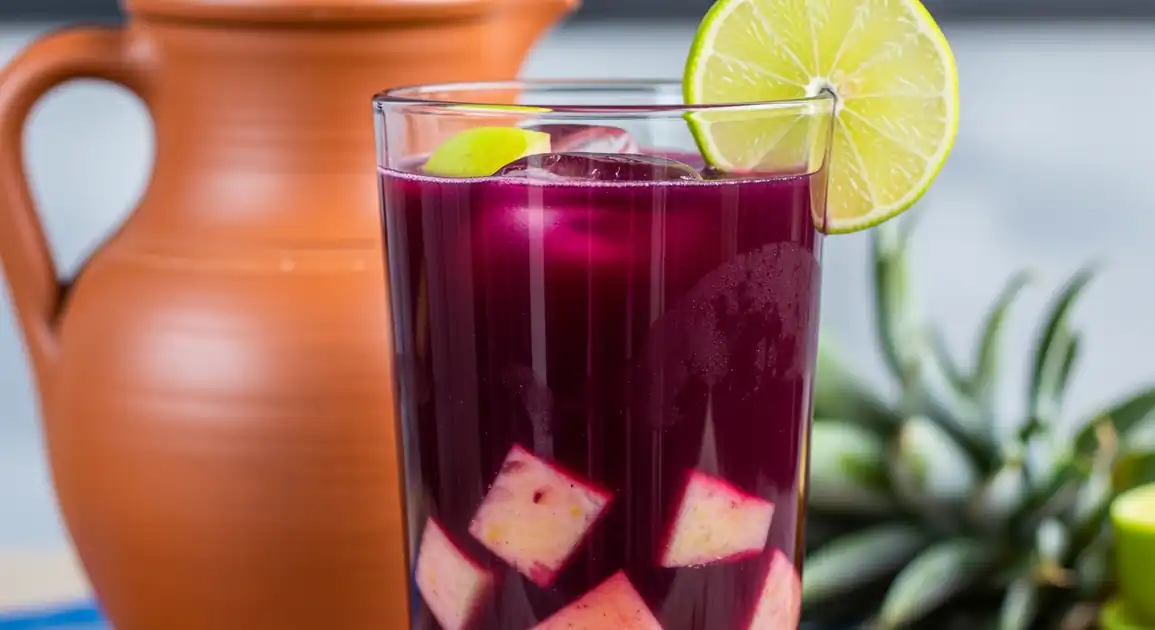Chicha Morada
Chicha Morada

Description
Chicha Morada is ubiquitous throughout Peru, considered a national beverage. It's a staple in homes, restaurants, and markets across all regions, enjoyed by people of all ages as a refreshing accompaniment to meals or on its own.
Dietary Information
Serving information
Serving style
Served cold, by the glass ('vaso') or pitcher ('jarra'). Often includes a straw. Sometimes garnished with a lime wedge or pineapple slice. Diced fruit may be mixed in.
Quick facts
Widely available during restaurant and market opening hours, typically 10 AM - 9 PM.
Safety Tips
What to Look For
-
Vibrant, deep purple color
Indicates proper concentration of purple corn used and freshness. Avoid dull, brownish, or overly pale drinks.
-
Served chilled from a clean, covered container
Refrigeration slows bacterial growth. Covered containers prevent contamination from dust, insects, or handling.
-
Reputable source with good turnover
Busy restaurants or popular market stalls are more likely to prepare fresh batches daily.
-
Fresh-looking fruit pieces (if added)
Chopped fruit added to the glass should appear fresh, not old or mushy.
-
Clear inquiry about ice source
Especially outside major cities or reliable restaurants, ensure ice is made from purified or boiled water ('hielo de agua tratada/hervida'). If unsure, order 'sin hielo'.
What to avoid
-
Drinks left open or unrefrigerated for long periods
Increases the risk of bacterial contamination and spoilage, especially in warm climates.
-
Vendors with visibly poor hygiene
Dirty hands, cloths, utensils, or containers significantly increase contamination risk.
-
Sour or fermented smell/taste
Indicates spoilage or unintended fermentation. Chicha Morada should taste fresh and sweet/tart, not sour.
-
Excessively cloudy or murky appearance
While not perfectly clear, extreme cloudiness could suggest improper preparation or the beginning of spoilage.
-
Re-used serving glasses that aren't washed properly
Observe if glasses are washed thoroughly between customers, especially at market stalls.
Price information
Price range
Budget tips
- Cheapest in markets ('mercados') or as part of a 'menú del día' (set lunch menu), often included for 2-4 PEN per glass.
- Ordering a pitcher ('jarra') is more economical for groups (8-15 PEN).
- Prices are higher in tourist-focused restaurants and upscale cafes.
Value indicators
- Deep, vibrant purple color.
- Balanced sweet and tart flavor.
- Served properly chilled.
- Included fruit pieces (if any) are fresh.
- Made with traditional spices (cinnamon/clove notes).
Where to Find This Dish
Local Restaurants ('Picanterías', 'Restaurantes')
Nearly all restaurants serving Peruvian cuisine will offer Chicha Morada.
Any restaurant serving 'Menú del Día'
Lunch (12 PM - 3 PM), Dinner (6 PM - 9 PM)
Central Markets ('Mercados Centrales')
Look for juice stalls ('juguerías') or dedicated drink vendors within the market.
Food/Juice sections of any major city market
Morning (9 AM - 12 PM), Lunchtime (12 PM - 2 PM)
Cafes and Bakeries ('Cafeterías', 'Pastelerías')
Many local cafes also serve it, sometimes alongside traditional pastries.
Local neighborhood cafes
All day
Vendor Tips
- Look for places where locals are drinking it.
- Don't be afraid to ask for 'menos azúcar' (less sugar) if you prefer it less sweet.
- Pitchers are usually better value for 2+ people.
How to Order
Regional Variations
-
Standard Chicha Morada
(Chicha Morada Clásica)
The most common version, boiled purple corn with pineapple, quince, spices, sweetened with sugar and lime juice.
-
Chicha Morada with extra fruit
(Chicha Morada con Fruta Picada)
Served with finely diced cooked apple, pineapple, or sometimes other fruits mixed into the glass.
-
Less Sweet Chicha Morada
(Chicha Morada bajo en azúcar / sin azúcar)
Prepared with reduced sugar or no added sugar, relying on the natural sweetness of the fruits. You can request this ('menos azúcar').
-
Emoliente con Chicha Morada
(Emoliente con Chicha Morada)
Sometimes mixed with Emoliente (another traditional Peruvian herbal drink) by street vendors, though less common.
-
Mazamorra Morada
(Mazamorra Morada)
Not a drink variation, but a related dessert. It's a thick, pudding-like dessert made from the same purple corn base, thickened with sweet potato flour or cornstarch and studded with fruits.
Cultural context
History
The use of purple corn in Peru dates back thousands of years, even pre-dating the Inca Empire. Chicha Morada as a prepared beverage likely evolved over centuries from ancient Andean traditions. While fermented 'chicha' was historically common, this sweet, boiled version gained widespread popularity as a daily drink and symbol of Peruvian culinary identity. It's now consumed nationwide, from homes to restaurants, representing a connection to Peru's rich agricultural heritage.
Local significance
A symbol of Peruvian identity and culinary heritage, deeply rooted in Andean agricultural traditions. It's more than just a drink; it's part of daily life and national pride.
Eating customs
- Sipped throughout the meal.
- Consumed chilled.
- The fruit pieces are often eaten with a spoon after finishing the liquid.